Control of Adult Smoking Inhalation Injury in Crisis
VerifiedAdded on 2022/11/29
|17
|1694
|129
Presentation
AI Summary
This presentation focuses on adult smoking inhalation injuries, discussing the causes, detection methods, pathophysiology, assessment, and nursing interventions. It aims to provide a comprehensive understanding of the condition and effective management strategies.
Contribute Materials
Your contribution can guide someone’s learning journey. Share your
documents today.
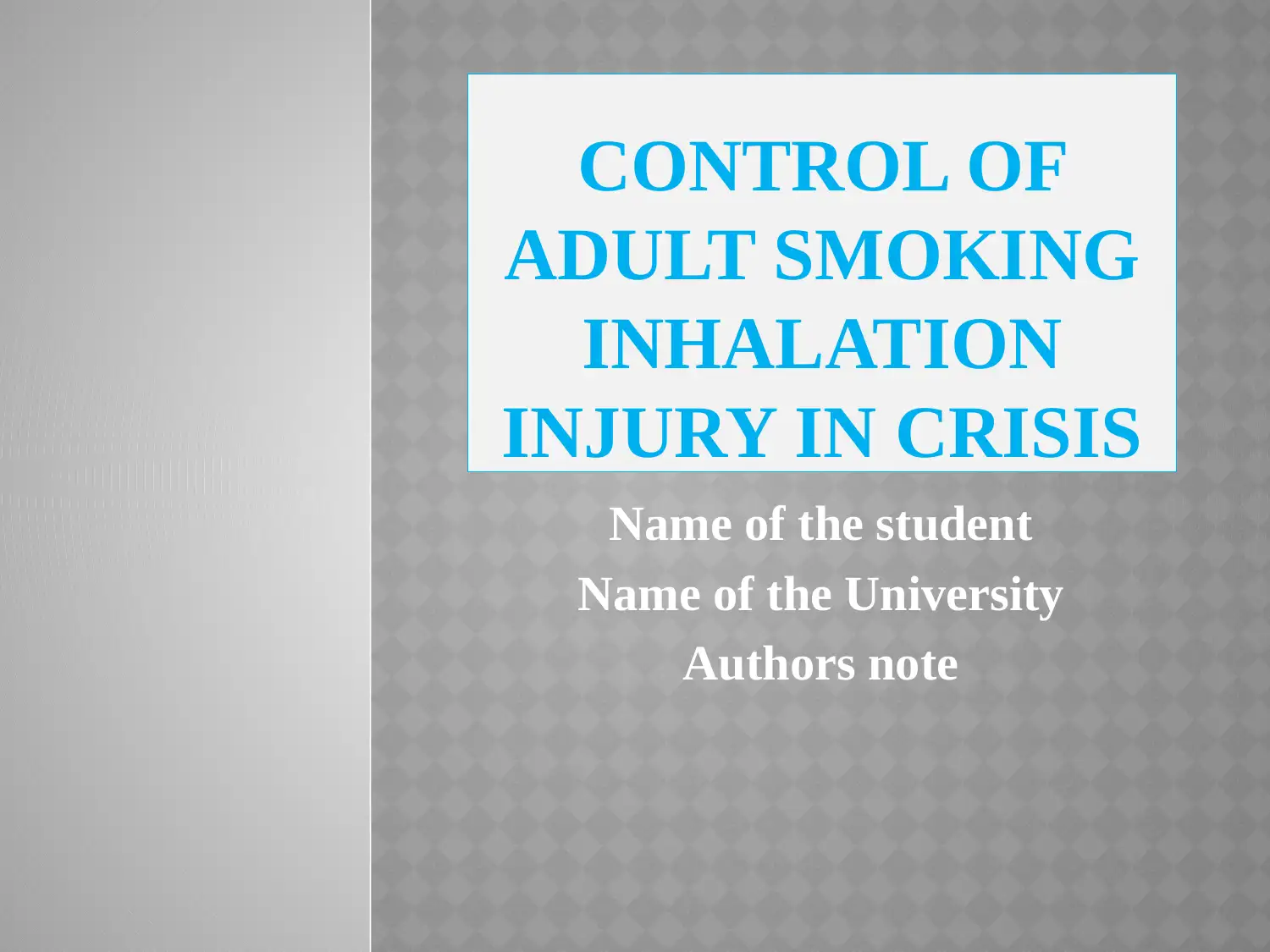
CONTROL OF
ADULT SMOKING
INHALATION
INJURY IN CRISIS
Name of the student
Name of the University
Authors note
ADULT SMOKING
INHALATION
INJURY IN CRISIS
Name of the student
Name of the University
Authors note
Secure Best Marks with AI Grader
Need help grading? Try our AI Grader for instant feedback on your assignments.
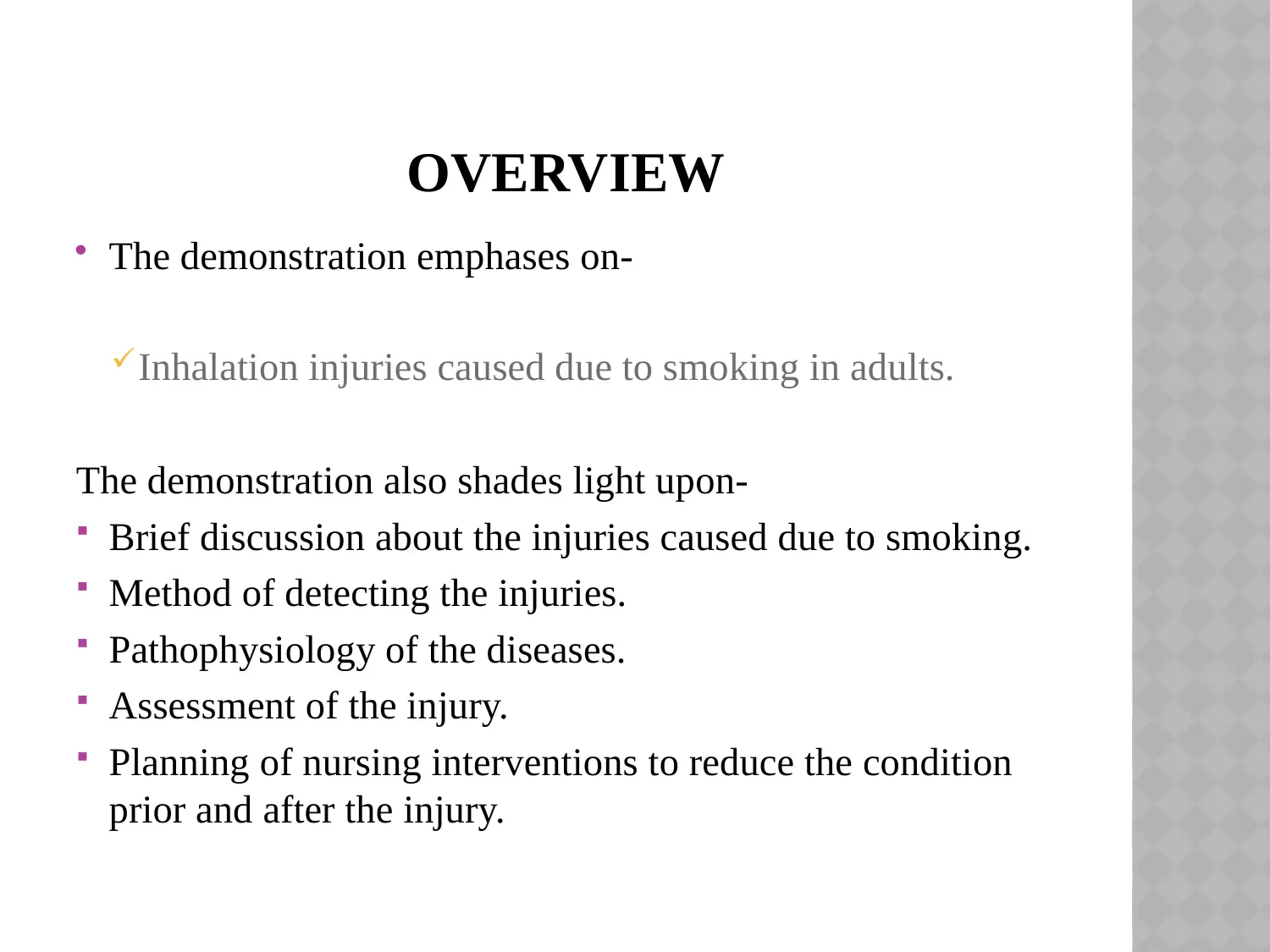
OVERVIEW
The demonstration emphases on-
Inhalation injuries caused due to smoking in adults.
The demonstration also shades light upon-
Brief discussion about the injuries caused due to smoking.
Method of detecting the injuries.
Pathophysiology of the diseases.
Assessment of the injury.
Planning of nursing interventions to reduce the condition
prior and after the injury.
The demonstration emphases on-
Inhalation injuries caused due to smoking in adults.
The demonstration also shades light upon-
Brief discussion about the injuries caused due to smoking.
Method of detecting the injuries.
Pathophysiology of the diseases.
Assessment of the injury.
Planning of nursing interventions to reduce the condition
prior and after the injury.
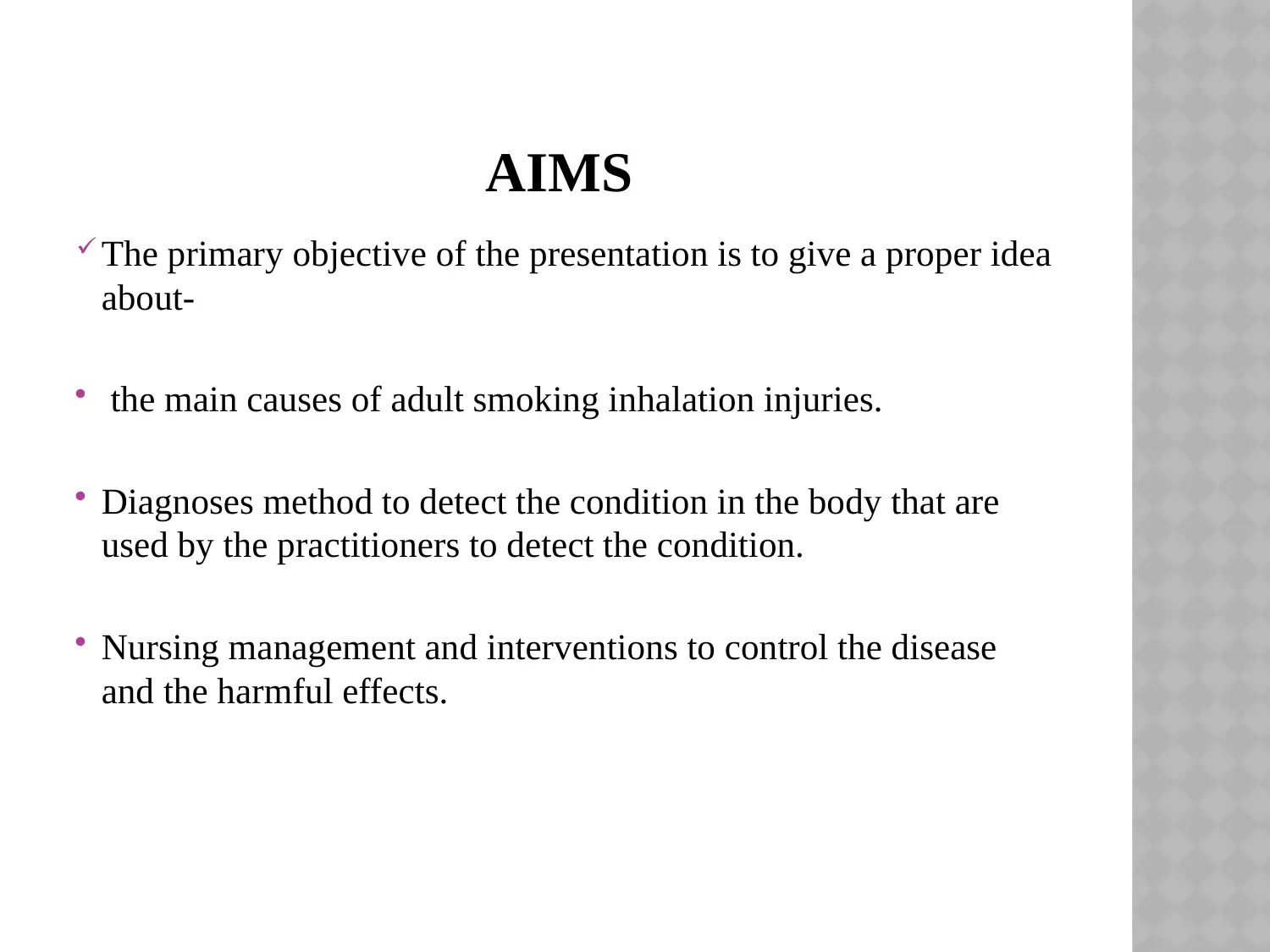
AIMS
The primary objective of the presentation is to give a proper idea
about-
the main causes of adult smoking inhalation injuries.
Diagnoses method to detect the condition in the body that are
used by the practitioners to detect the condition.
Nursing management and interventions to control the disease
and the harmful effects.
The primary objective of the presentation is to give a proper idea
about-
the main causes of adult smoking inhalation injuries.
Diagnoses method to detect the condition in the body that are
used by the practitioners to detect the condition.
Nursing management and interventions to control the disease
and the harmful effects.
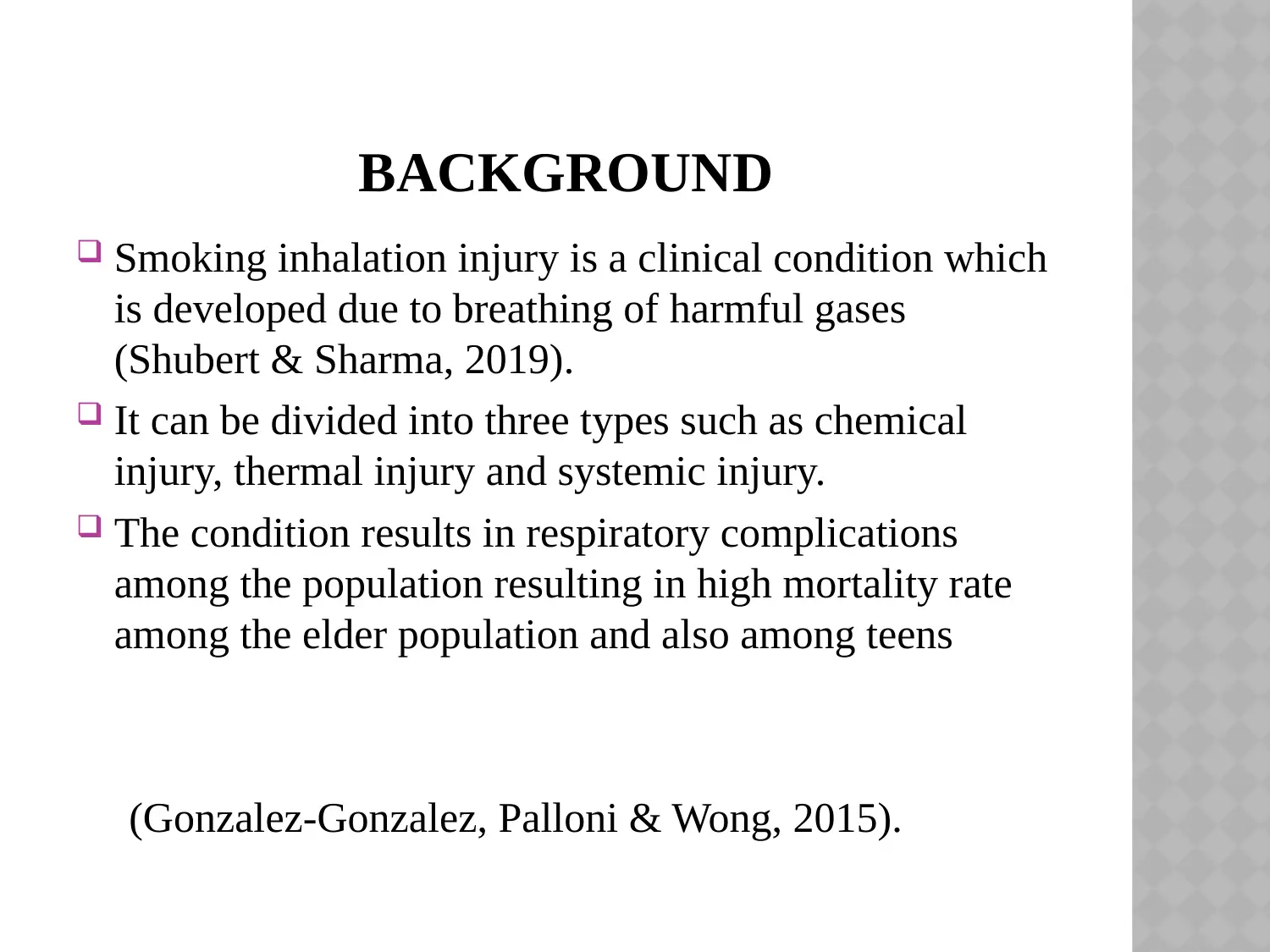
BACKGROUND
Smoking inhalation injury is a clinical condition which
is developed due to breathing of harmful gases
(Shubert & Sharma, 2019).
It can be divided into three types such as chemical
injury, thermal injury and systemic injury.
The condition results in respiratory complications
among the population resulting in high mortality rate
among the elder population and also among teens
(Gonzalez-Gonzalez, Palloni & Wong, 2015).
Smoking inhalation injury is a clinical condition which
is developed due to breathing of harmful gases
(Shubert & Sharma, 2019).
It can be divided into three types such as chemical
injury, thermal injury and systemic injury.
The condition results in respiratory complications
among the population resulting in high mortality rate
among the elder population and also among teens
(Gonzalez-Gonzalez, Palloni & Wong, 2015).
Secure Best Marks with AI Grader
Need help grading? Try our AI Grader for instant feedback on your assignments.
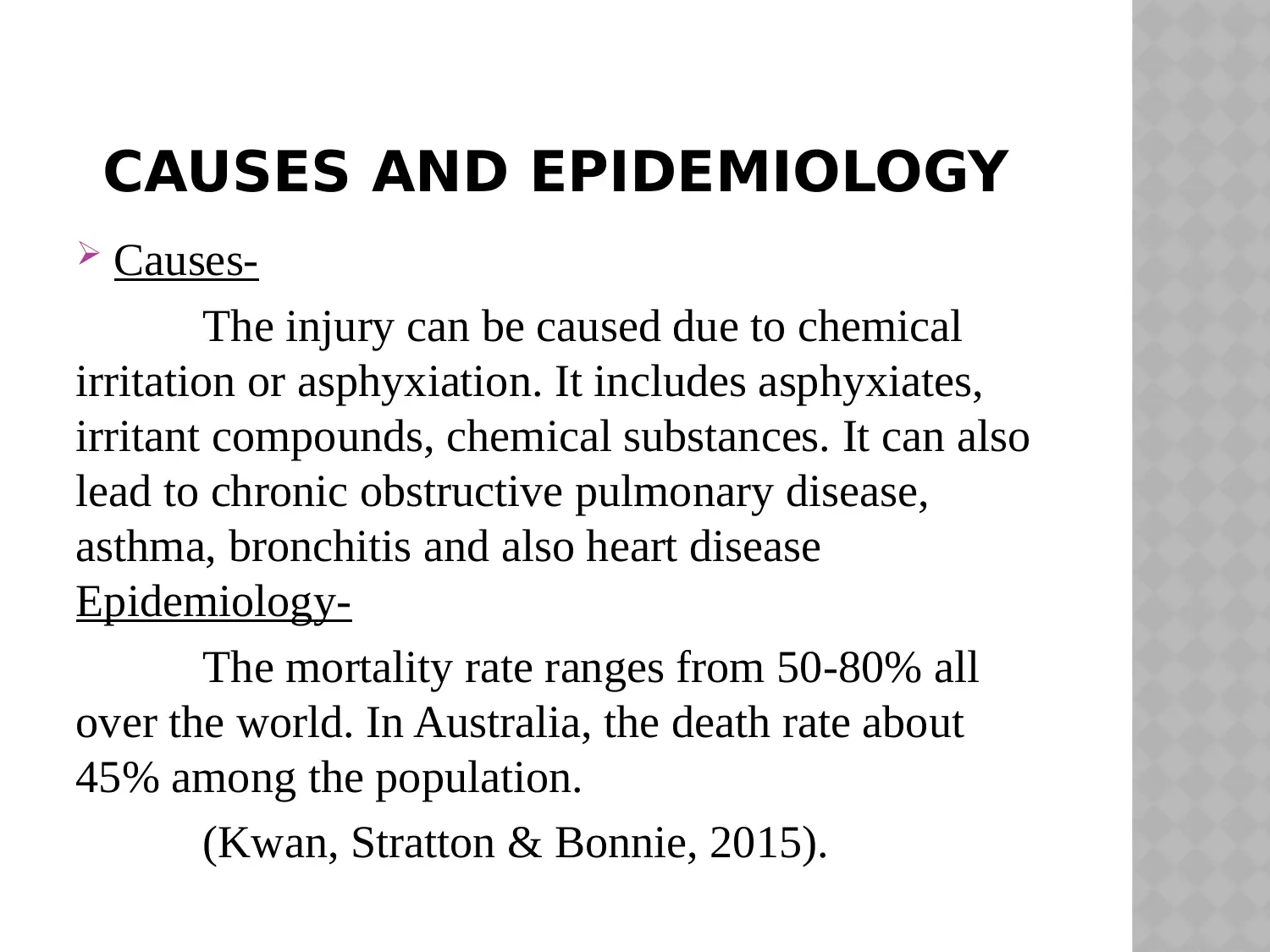
CAUSES AND EPIDEMIOLOGY
Causes-
The injury can be caused due to chemical
irritation or asphyxiation. It includes asphyxiates,
irritant compounds, chemical substances. It can also
lead to chronic obstructive pulmonary disease,
asthma, bronchitis and also heart disease
Epidemiology-
The mortality rate ranges from 50-80% all
over the world. In Australia, the death rate about
45% among the population.
(Kwan, Stratton & Bonnie, 2015).
Causes-
The injury can be caused due to chemical
irritation or asphyxiation. It includes asphyxiates,
irritant compounds, chemical substances. It can also
lead to chronic obstructive pulmonary disease,
asthma, bronchitis and also heart disease
Epidemiology-
The mortality rate ranges from 50-80% all
over the world. In Australia, the death rate about
45% among the population.
(Kwan, Stratton & Bonnie, 2015).
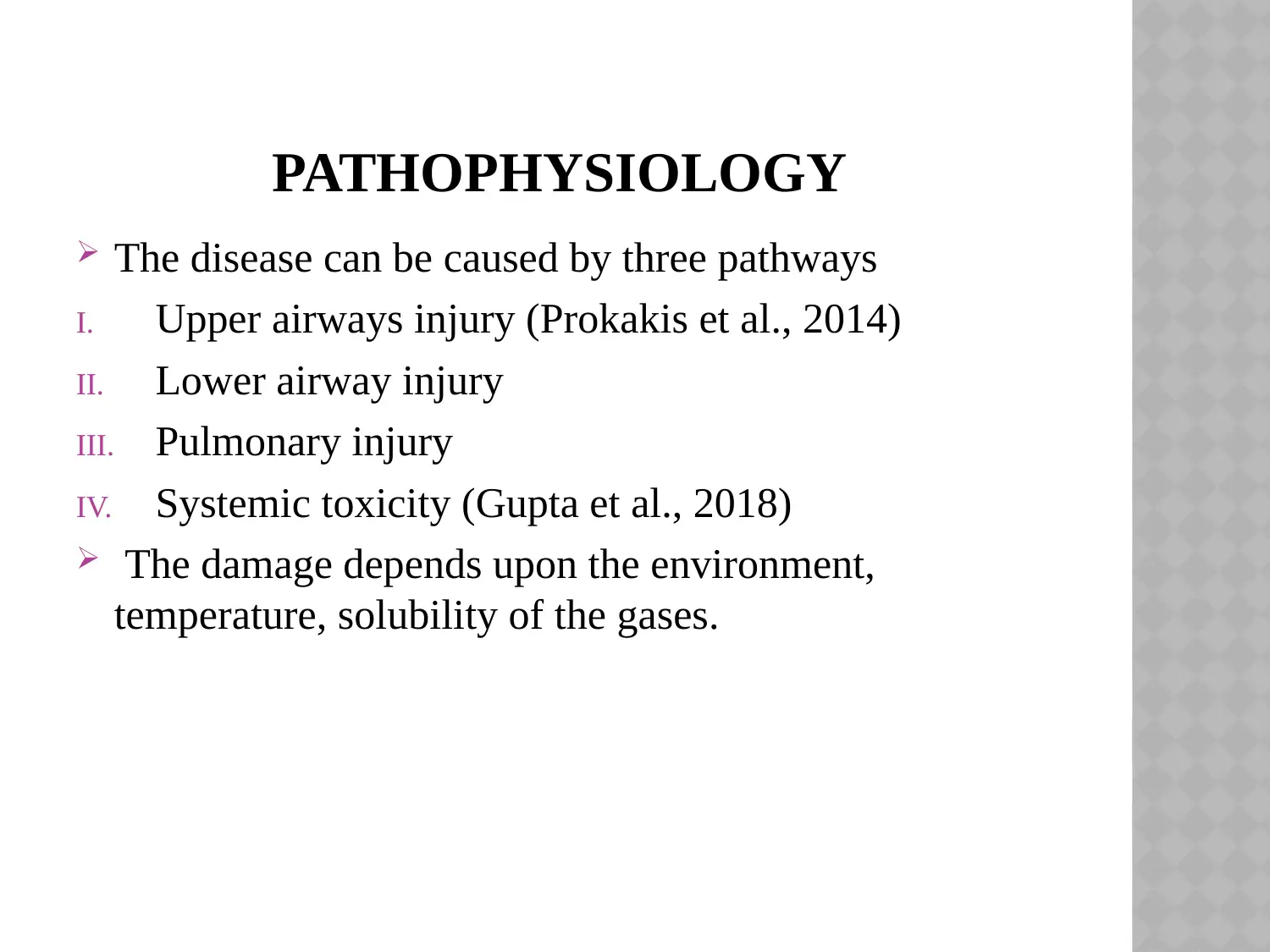
PATHOPHYSIOLOGY
The disease can be caused by three pathways
I. Upper airways injury (Prokakis et al., 2014)
II. Lower airway injury
III. Pulmonary injury
IV. Systemic toxicity (Gupta et al., 2018)
The damage depends upon the environment,
temperature, solubility of the gases.
The disease can be caused by three pathways
I. Upper airways injury (Prokakis et al., 2014)
II. Lower airway injury
III. Pulmonary injury
IV. Systemic toxicity (Gupta et al., 2018)
The damage depends upon the environment,
temperature, solubility of the gases.
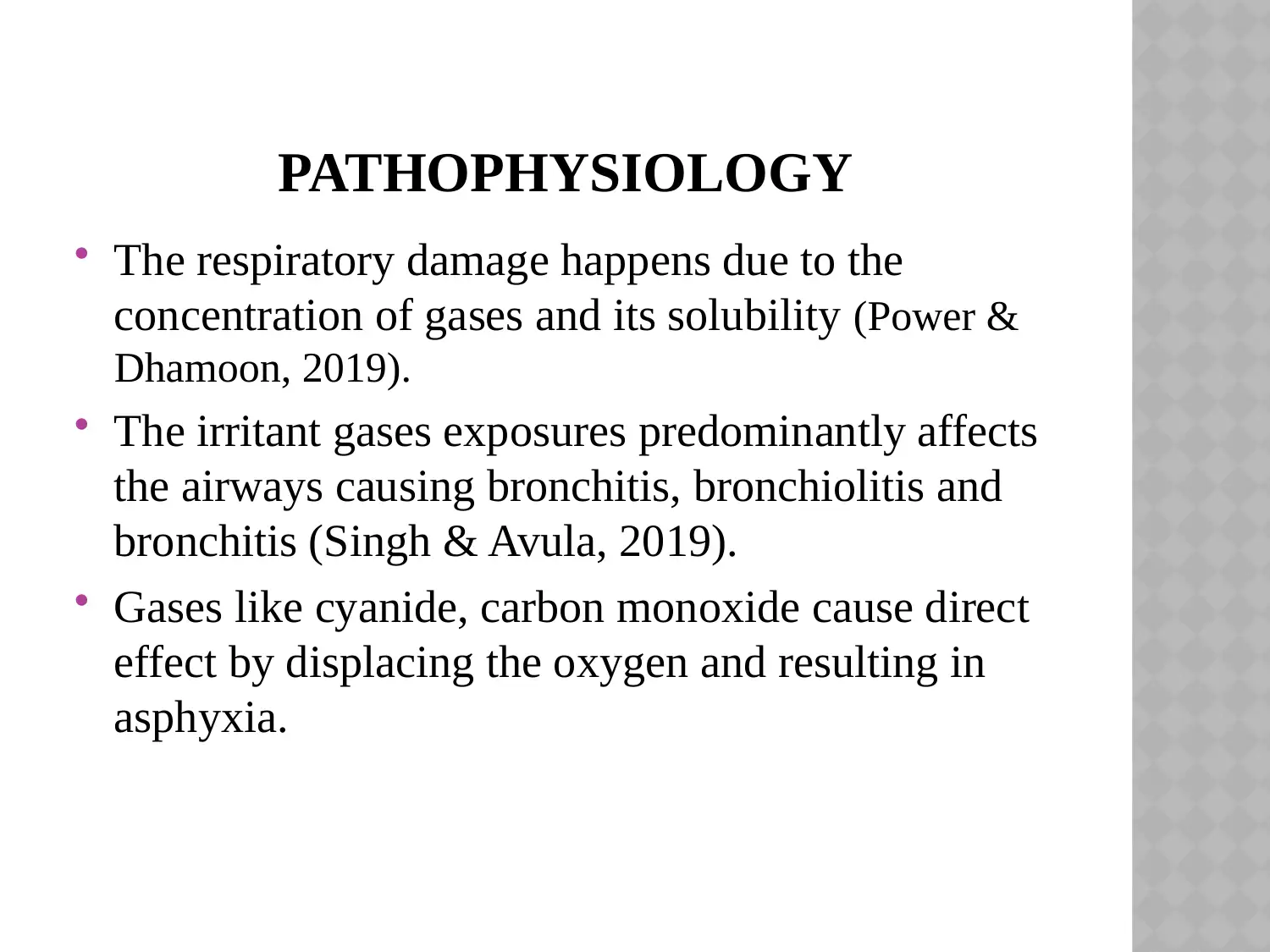
PATHOPHYSIOLOGY
The respiratory damage happens due to the
concentration of gases and its solubility (Power &
Dhamoon, 2019).
The irritant gases exposures predominantly affects
the airways causing bronchitis, bronchiolitis and
bronchitis (Singh & Avula, 2019).
Gases like cyanide, carbon monoxide cause direct
effect by displacing the oxygen and resulting in
asphyxia.
The respiratory damage happens due to the
concentration of gases and its solubility (Power &
Dhamoon, 2019).
The irritant gases exposures predominantly affects
the airways causing bronchitis, bronchiolitis and
bronchitis (Singh & Avula, 2019).
Gases like cyanide, carbon monoxide cause direct
effect by displacing the oxygen and resulting in
asphyxia.
Paraphrase This Document
Need a fresh take? Get an instant paraphrase of this document with our AI Paraphraser
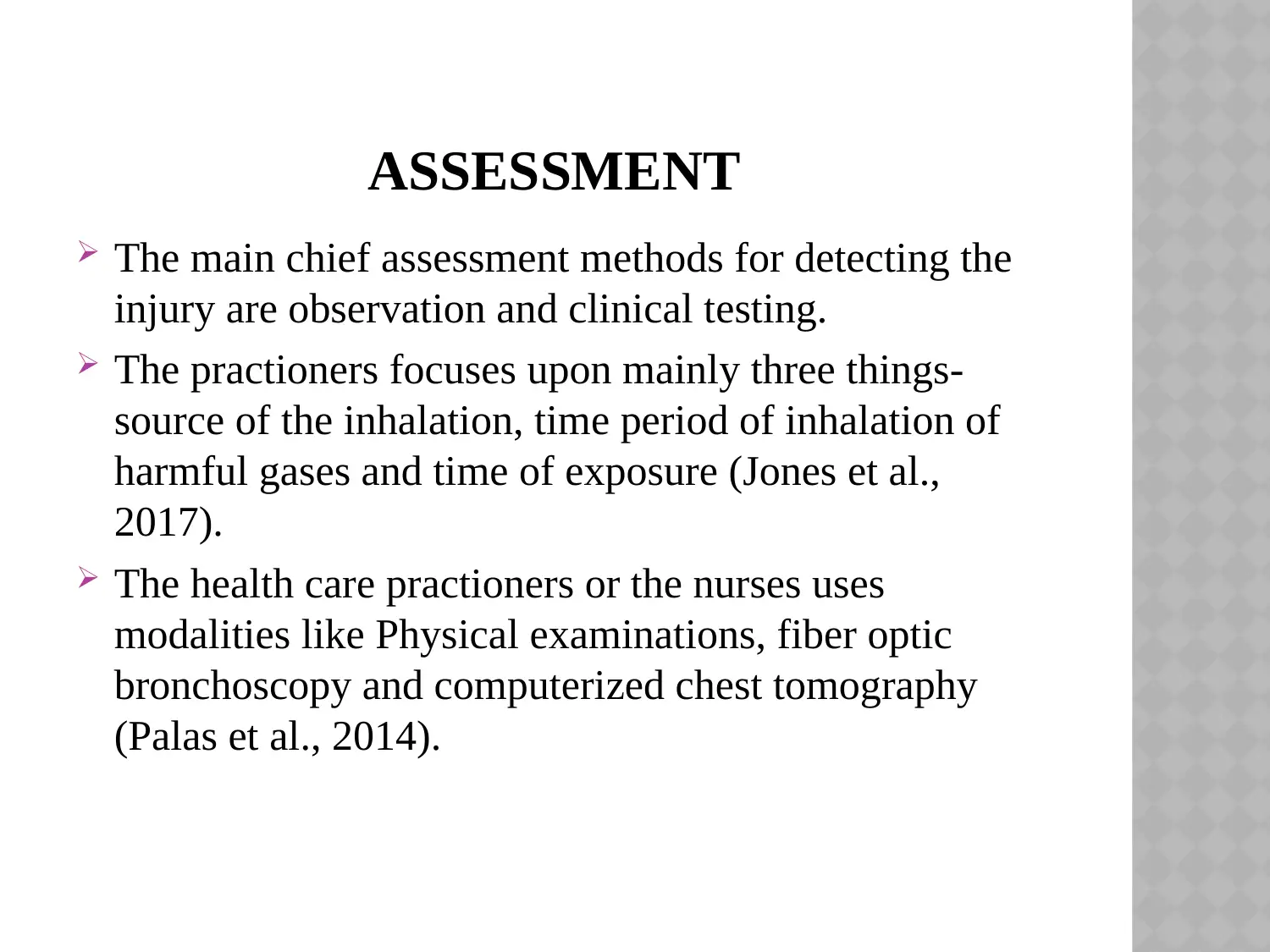
ASSESSMENT
The main chief assessment methods for detecting the
injury are observation and clinical testing.
The practioners focuses upon mainly three things-
source of the inhalation, time period of inhalation of
harmful gases and time of exposure (Jones et al.,
2017).
The health care practioners or the nurses uses
modalities like Physical examinations, fiber optic
bronchoscopy and computerized chest tomography
(Palas et al., 2014).
The main chief assessment methods for detecting the
injury are observation and clinical testing.
The practioners focuses upon mainly three things-
source of the inhalation, time period of inhalation of
harmful gases and time of exposure (Jones et al.,
2017).
The health care practioners or the nurses uses
modalities like Physical examinations, fiber optic
bronchoscopy and computerized chest tomography
(Palas et al., 2014).
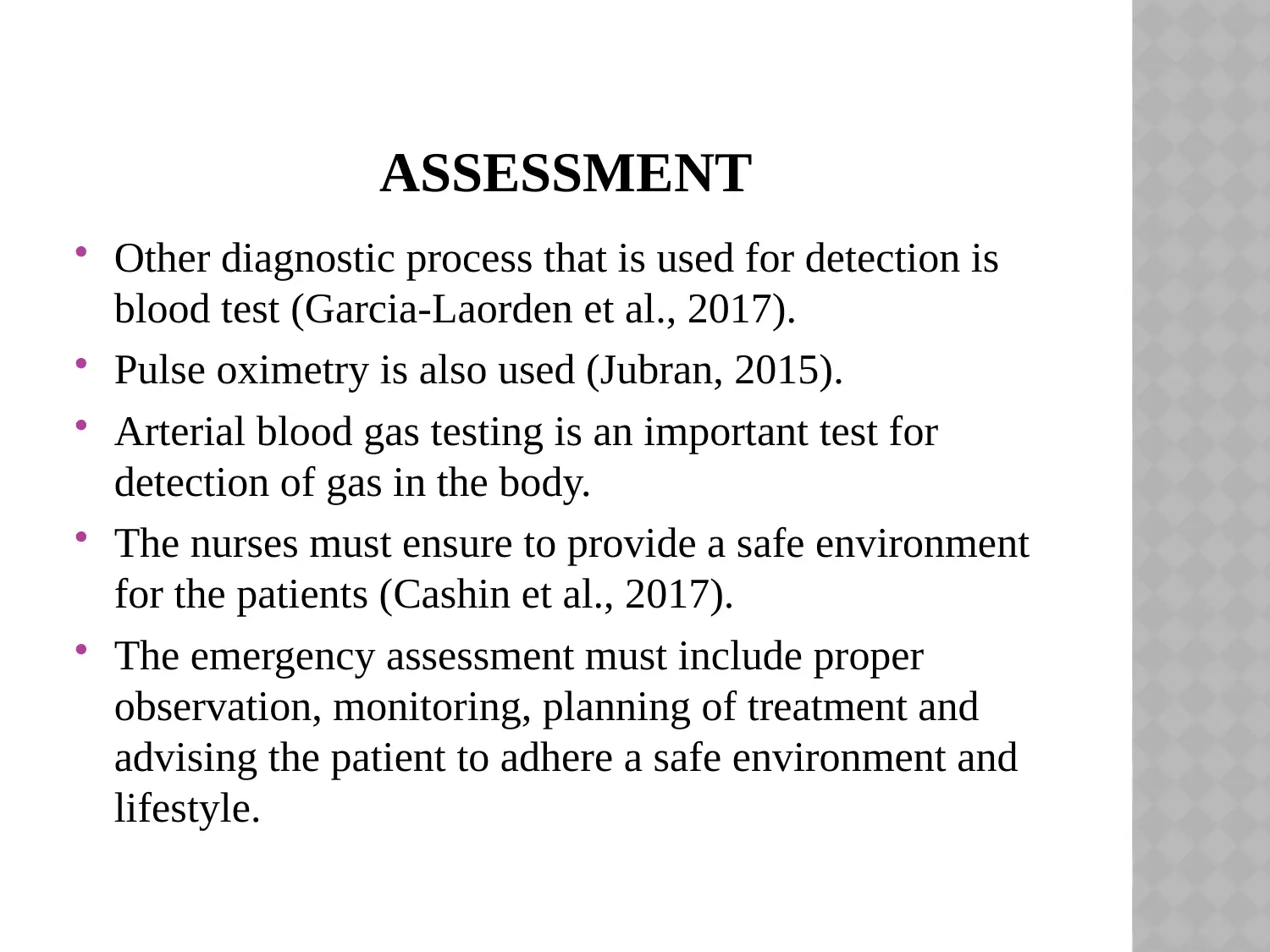
ASSESSMENT
Other diagnostic process that is used for detection is
blood test (Garcia-Laorden et al., 2017).
Pulse oximetry is also used (Jubran, 2015).
Arterial blood gas testing is an important test for
detection of gas in the body.
The nurses must ensure to provide a safe environment
for the patients (Cashin et al., 2017).
The emergency assessment must include proper
observation, monitoring, planning of treatment and
advising the patient to adhere a safe environment and
lifestyle.
Other diagnostic process that is used for detection is
blood test (Garcia-Laorden et al., 2017).
Pulse oximetry is also used (Jubran, 2015).
Arterial blood gas testing is an important test for
detection of gas in the body.
The nurses must ensure to provide a safe environment
for the patients (Cashin et al., 2017).
The emergency assessment must include proper
observation, monitoring, planning of treatment and
advising the patient to adhere a safe environment and
lifestyle.
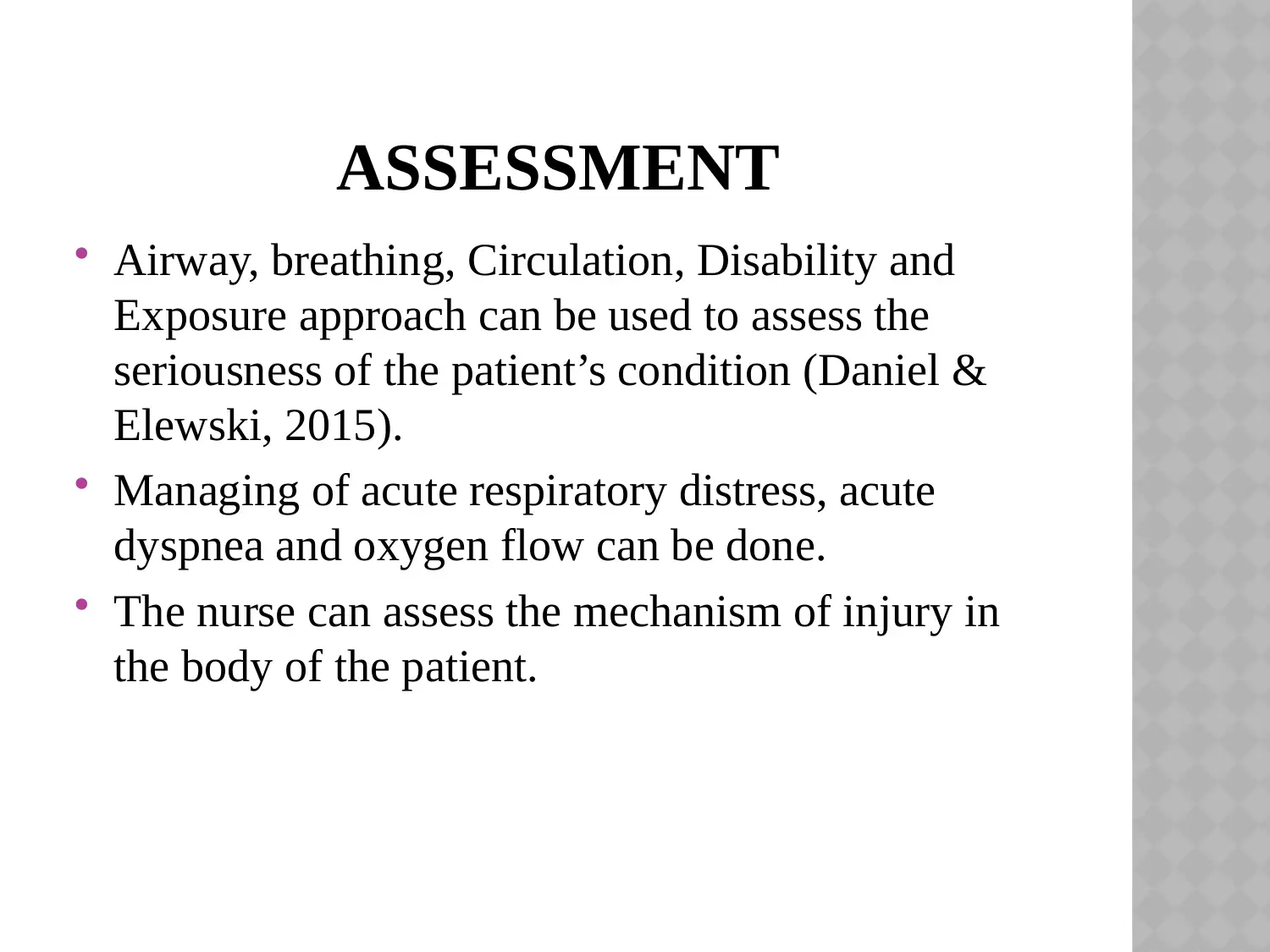
ASSESSMENT
Airway, breathing, Circulation, Disability and
Exposure approach can be used to assess the
seriousness of the patient’s condition (Daniel &
Elewski, 2015).
Managing of acute respiratory distress, acute
dyspnea and oxygen flow can be done.
The nurse can assess the mechanism of injury in
the body of the patient.
Airway, breathing, Circulation, Disability and
Exposure approach can be used to assess the
seriousness of the patient’s condition (Daniel &
Elewski, 2015).
Managing of acute respiratory distress, acute
dyspnea and oxygen flow can be done.
The nurse can assess the mechanism of injury in
the body of the patient.
Secure Best Marks with AI Grader
Need help grading? Try our AI Grader for instant feedback on your assignments.
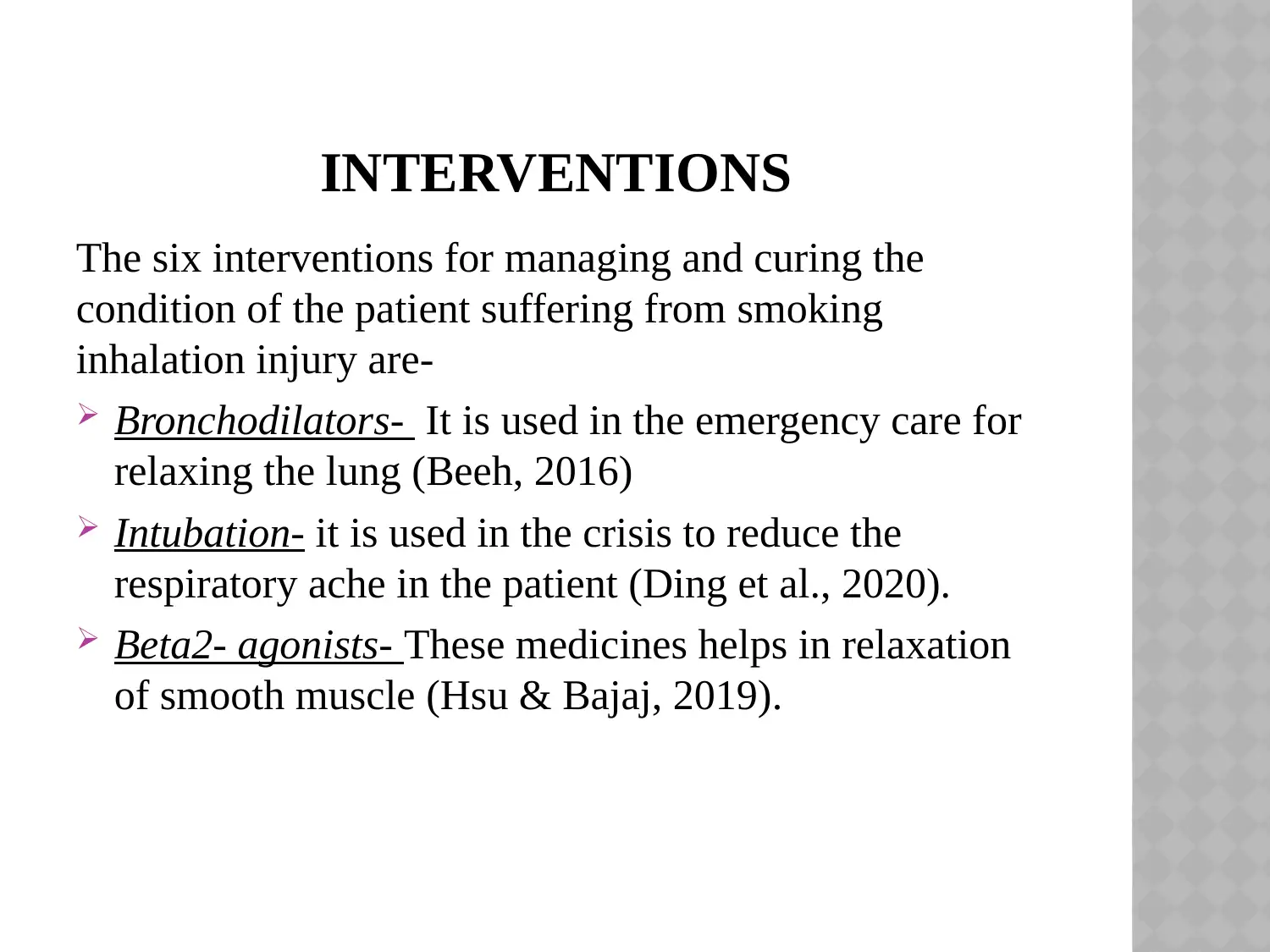
INTERVENTIONS
The six interventions for managing and curing the
condition of the patient suffering from smoking
inhalation injury are-
Bronchodilators- It is used in the emergency care for
relaxing the lung (Beeh, 2016)
Intubation- it is used in the crisis to reduce the
respiratory ache in the patient (Ding et al., 2020).
Beta2- agonists- These medicines helps in relaxation
of smooth muscle (Hsu & Bajaj, 2019).
The six interventions for managing and curing the
condition of the patient suffering from smoking
inhalation injury are-
Bronchodilators- It is used in the emergency care for
relaxing the lung (Beeh, 2016)
Intubation- it is used in the crisis to reduce the
respiratory ache in the patient (Ding et al., 2020).
Beta2- agonists- These medicines helps in relaxation
of smooth muscle (Hsu & Bajaj, 2019).
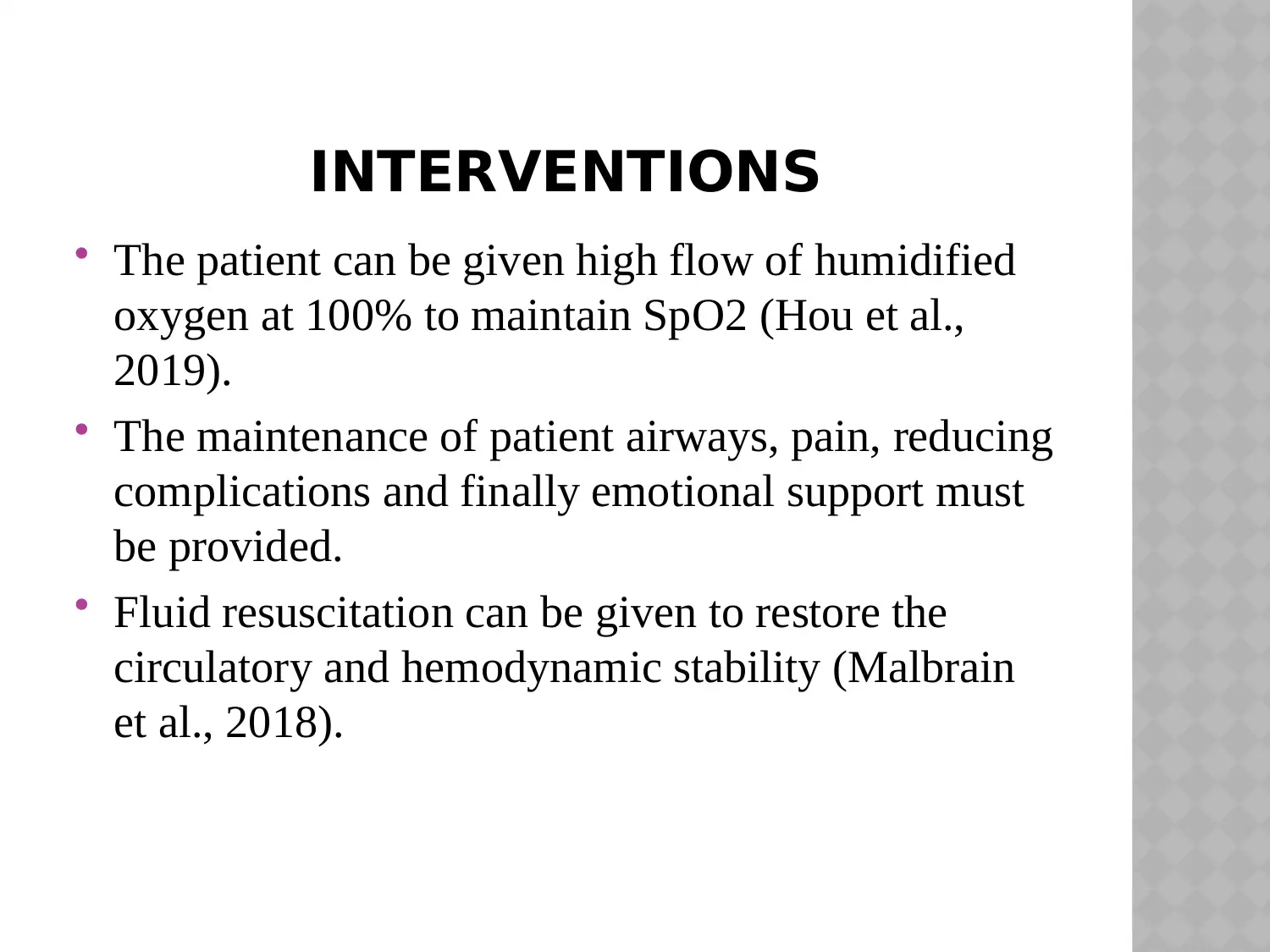
INTERVENTIONS
The patient can be given high flow of humidified
oxygen at 100% to maintain SpO2 (Hou et al.,
2019).
The maintenance of patient airways, pain, reducing
complications and finally emotional support must
be provided.
Fluid resuscitation can be given to restore the
circulatory and hemodynamic stability (Malbrain
et al., 2018).
The patient can be given high flow of humidified
oxygen at 100% to maintain SpO2 (Hou et al.,
2019).
The maintenance of patient airways, pain, reducing
complications and finally emotional support must
be provided.
Fluid resuscitation can be given to restore the
circulatory and hemodynamic stability (Malbrain
et al., 2018).
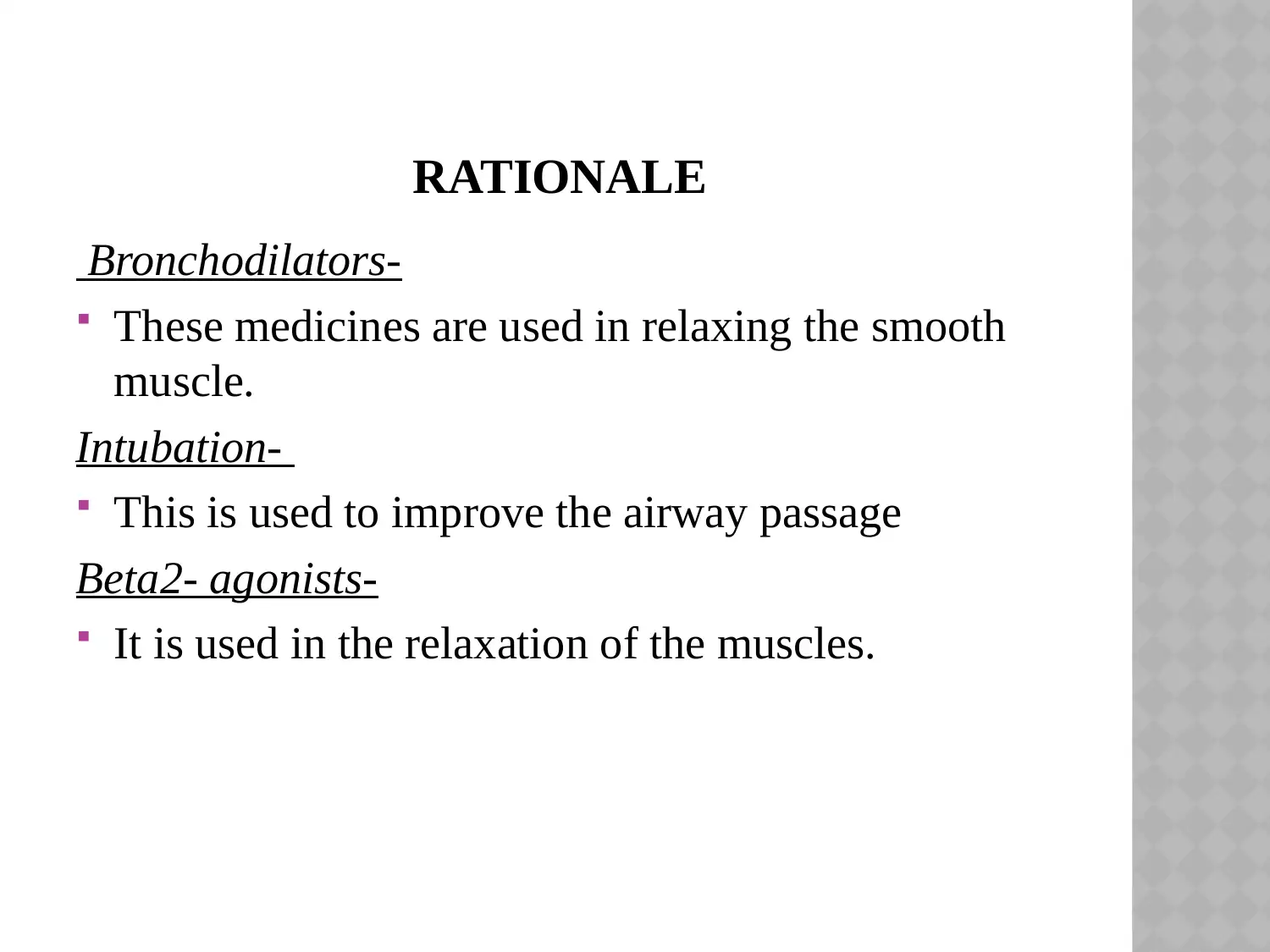
RATIONALE
Bronchodilators-
These medicines are used in relaxing the smooth
muscle.
Intubation-
This is used to improve the airway passage
Beta2- agonists-
It is used in the relaxation of the muscles.
Bronchodilators-
These medicines are used in relaxing the smooth
muscle.
Intubation-
This is used to improve the airway passage
Beta2- agonists-
It is used in the relaxation of the muscles.
Paraphrase This Document
Need a fresh take? Get an instant paraphrase of this document with our AI Paraphraser
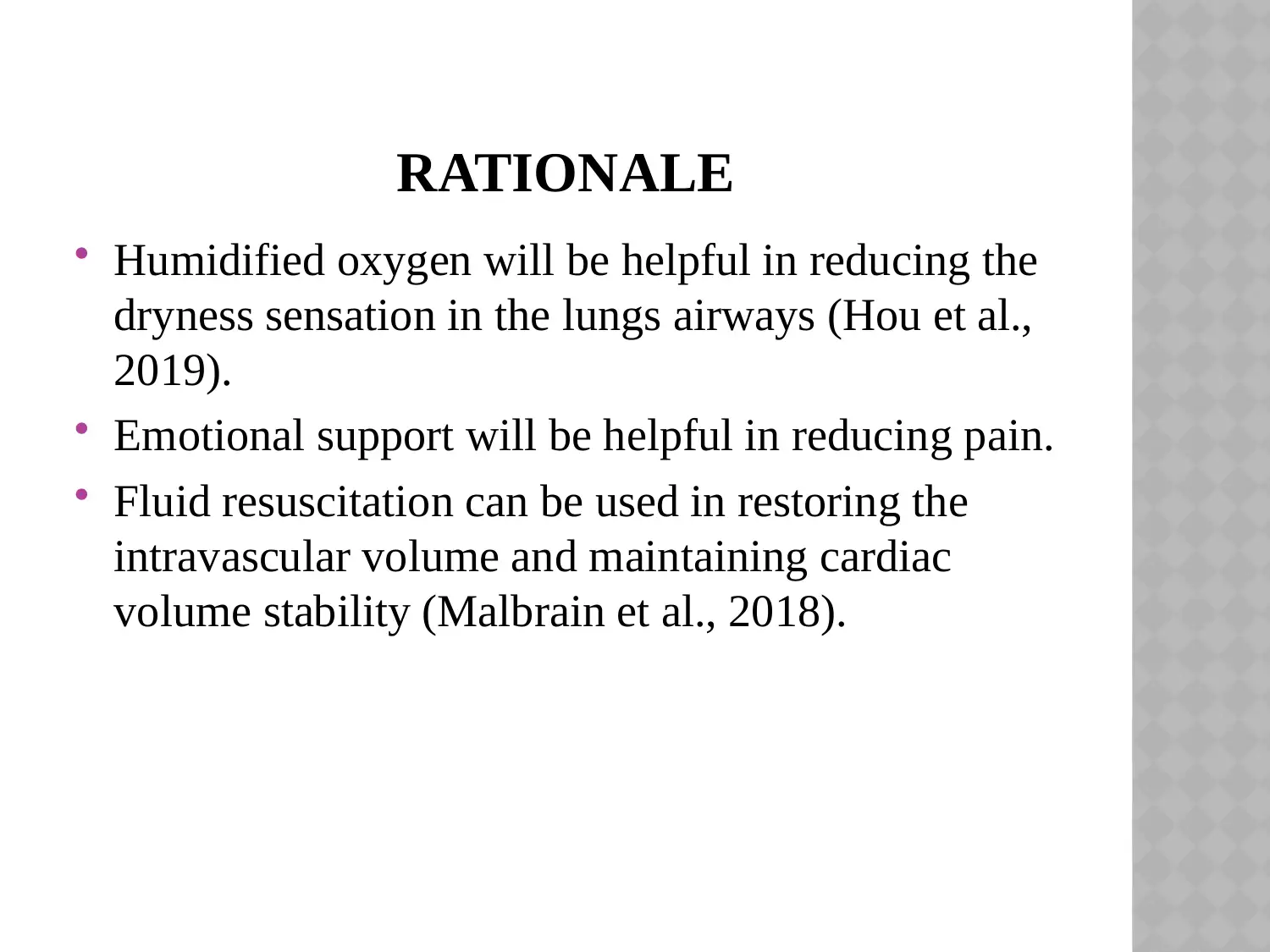
RATIONALE
Humidified oxygen will be helpful in reducing the
dryness sensation in the lungs airways (Hou et al.,
2019).
Emotional support will be helpful in reducing pain.
Fluid resuscitation can be used in restoring the
intravascular volume and maintaining cardiac
volume stability (Malbrain et al., 2018).
Humidified oxygen will be helpful in reducing the
dryness sensation in the lungs airways (Hou et al.,
2019).
Emotional support will be helpful in reducing pain.
Fluid resuscitation can be used in restoring the
intravascular volume and maintaining cardiac
volume stability (Malbrain et al., 2018).
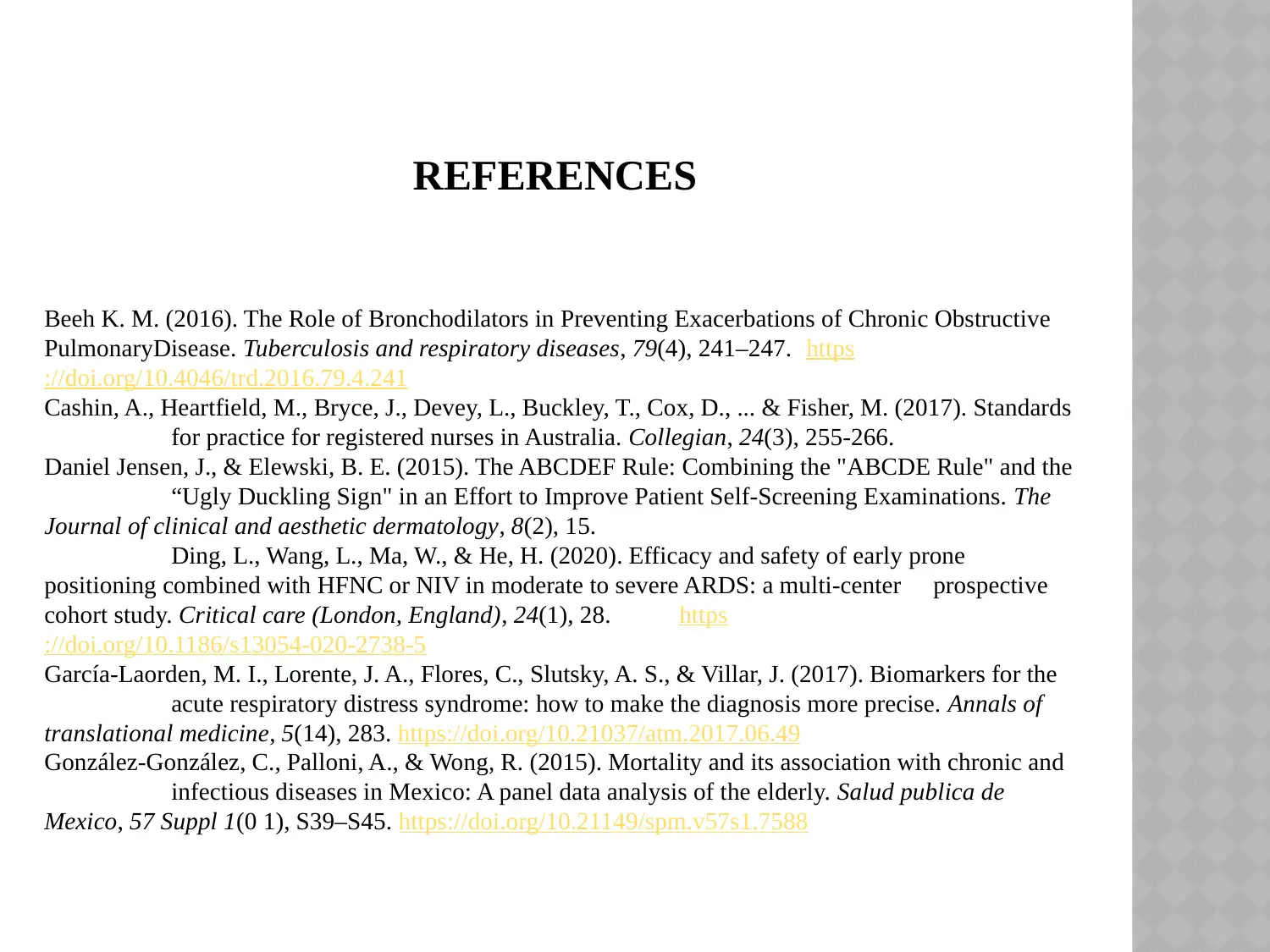
REFERENCES
Beeh K. M. (2016). The Role of Bronchodilators in Preventing Exacerbations of Chronic Obstructive
PulmonaryDisease. Tuberculosis and respiratory diseases, 79(4), 241–247. https
://doi.org/10.4046/trd.2016.79.4.241
Cashin, A., Heartfield, M., Bryce, J., Devey, L., Buckley, T., Cox, D., ... & Fisher, M. (2017). Standards
for practice for registered nurses in Australia. Collegian, 24(3), 255-266.
Daniel Jensen, J., & Elewski, B. E. (2015). The ABCDEF Rule: Combining the "ABCDE Rule" and the
“Ugly Duckling Sign" in an Effort to Improve Patient Self-Screening Examinations. The
Journal of clinical and aesthetic dermatology, 8(2), 15.
Ding, L., Wang, L., Ma, W., & He, H. (2020). Efficacy and safety of early prone
positioning combined with HFNC or NIV in moderate to severe ARDS: a multi-center prospective
cohort study. Critical care (London, England), 24(1), 28. https
://doi.org/10.1186/s13054-020-2738-5
García-Laorden, M. I., Lorente, J. A., Flores, C., Slutsky, A. S., & Villar, J. (2017). Biomarkers for the
acute respiratory distress syndrome: how to make the diagnosis more precise. Annals of
translational medicine, 5(14), 283. https://doi.org/10.21037/atm.2017.06.49
González-González, C., Palloni, A., & Wong, R. (2015). Mortality and its association with chronic and
infectious diseases in Mexico: A panel data analysis of the elderly. Salud publica de
Mexico, 57 Suppl 1(0 1), S39–S45. https://doi.org/10.21149/spm.v57s1.7588
Beeh K. M. (2016). The Role of Bronchodilators in Preventing Exacerbations of Chronic Obstructive
PulmonaryDisease. Tuberculosis and respiratory diseases, 79(4), 241–247. https
://doi.org/10.4046/trd.2016.79.4.241
Cashin, A., Heartfield, M., Bryce, J., Devey, L., Buckley, T., Cox, D., ... & Fisher, M. (2017). Standards
for practice for registered nurses in Australia. Collegian, 24(3), 255-266.
Daniel Jensen, J., & Elewski, B. E. (2015). The ABCDEF Rule: Combining the "ABCDE Rule" and the
“Ugly Duckling Sign" in an Effort to Improve Patient Self-Screening Examinations. The
Journal of clinical and aesthetic dermatology, 8(2), 15.
Ding, L., Wang, L., Ma, W., & He, H. (2020). Efficacy and safety of early prone
positioning combined with HFNC or NIV in moderate to severe ARDS: a multi-center prospective
cohort study. Critical care (London, England), 24(1), 28. https
://doi.org/10.1186/s13054-020-2738-5
García-Laorden, M. I., Lorente, J. A., Flores, C., Slutsky, A. S., & Villar, J. (2017). Biomarkers for the
acute respiratory distress syndrome: how to make the diagnosis more precise. Annals of
translational medicine, 5(14), 283. https://doi.org/10.21037/atm.2017.06.49
González-González, C., Palloni, A., & Wong, R. (2015). Mortality and its association with chronic and
infectious diseases in Mexico: A panel data analysis of the elderly. Salud publica de
Mexico, 57 Suppl 1(0 1), S39–S45. https://doi.org/10.21149/spm.v57s1.7588
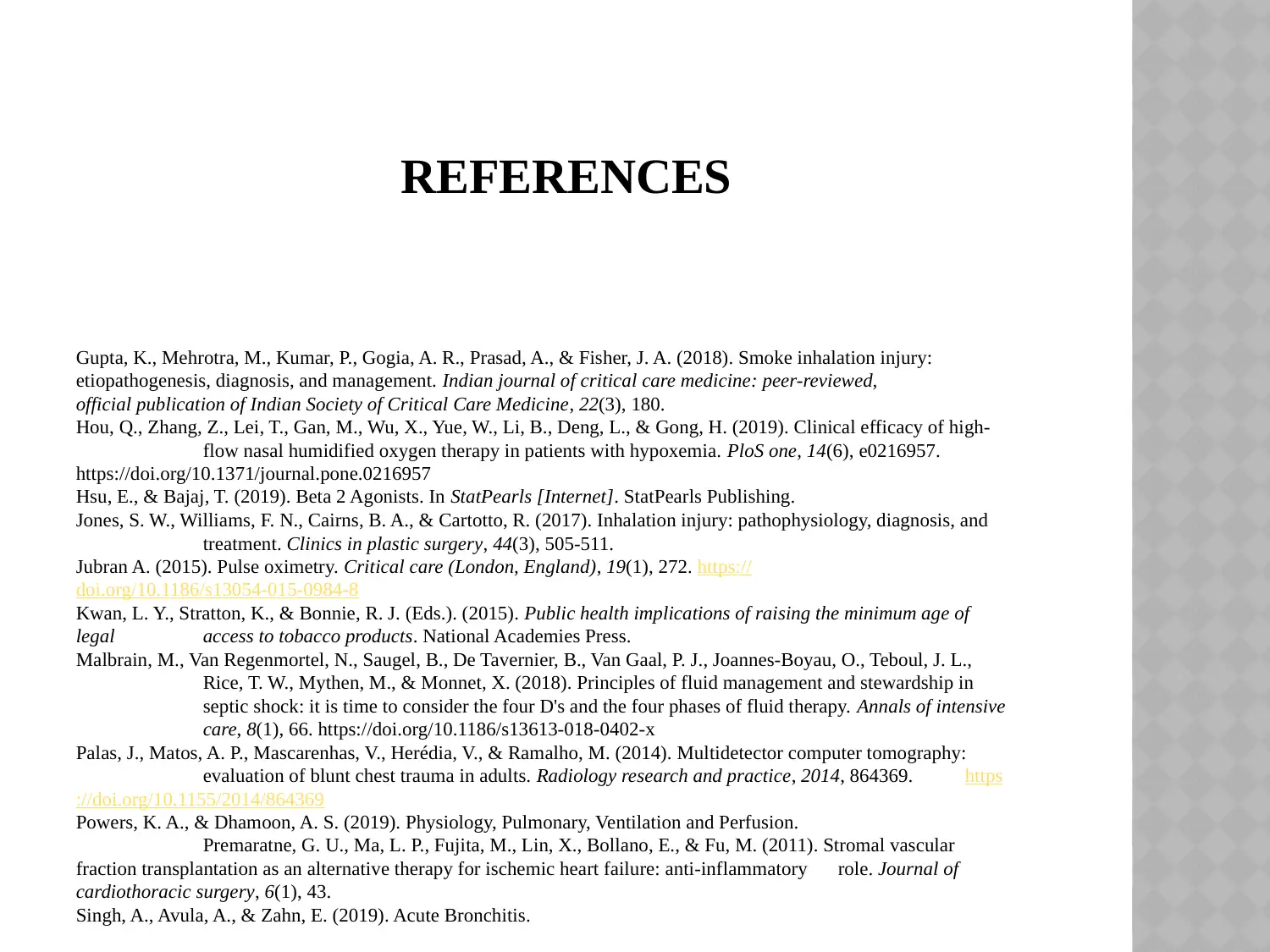
REFERENCES
Gupta, K., Mehrotra, M., Kumar, P., Gogia, A. R., Prasad, A., & Fisher, J. A. (2018). Smoke inhalation injury:
etiopathogenesis, diagnosis, and management. Indian journal of critical care medicine: peer-reviewed,
official publication of Indian Society of Critical Care Medicine, 22(3), 180.
Hou, Q., Zhang, Z., Lei, T., Gan, M., Wu, X., Yue, W., Li, B., Deng, L., & Gong, H. (2019). Clinical efficacy of high-
flow nasal humidified oxygen therapy in patients with hypoxemia. PloS one, 14(6), e0216957.
https://doi.org/10.1371/journal.pone.0216957
Hsu, E., & Bajaj, T. (2019). Beta 2 Agonists. In StatPearls [Internet]. StatPearls Publishing.
Jones, S. W., Williams, F. N., Cairns, B. A., & Cartotto, R. (2017). Inhalation injury: pathophysiology, diagnosis, and
treatment. Clinics in plastic surgery, 44(3), 505-511.
Jubran A. (2015). Pulse oximetry. Critical care (London, England), 19(1), 272. https://
doi.org/10.1186/s13054-015-0984-8
Kwan, L. Y., Stratton, K., & Bonnie, R. J. (Eds.). (2015). Public health implications of raising the minimum age of
legal access to tobacco products. National Academies Press.
Malbrain, M., Van Regenmortel, N., Saugel, B., De Tavernier, B., Van Gaal, P. J., Joannes-Boyau, O., Teboul, J. L.,
Rice, T. W., Mythen, M., & Monnet, X. (2018). Principles of fluid management and stewardship in
septic shock: it is time to consider the four D's and the four phases of fluid therapy. Annals of intensive
care, 8(1), 66. https://doi.org/10.1186/s13613-018-0402-x
Palas, J., Matos, A. P., Mascarenhas, V., Herédia, V., & Ramalho, M. (2014). Multidetector computer tomography:
evaluation of blunt chest trauma in adults. Radiology research and practice, 2014, 864369. https
://doi.org/10.1155/2014/864369
Powers, K. A., & Dhamoon, A. S. (2019). Physiology, Pulmonary, Ventilation and Perfusion.
Premaratne, G. U., Ma, L. P., Fujita, M., Lin, X., Bollano, E., & Fu, M. (2011). Stromal vascular
fraction transplantation as an alternative therapy for ischemic heart failure: anti-inflammatory role. Journal of
cardiothoracic surgery, 6(1), 43.
Singh, A., Avula, A., & Zahn, E. (2019). Acute Bronchitis.
Gupta, K., Mehrotra, M., Kumar, P., Gogia, A. R., Prasad, A., & Fisher, J. A. (2018). Smoke inhalation injury:
etiopathogenesis, diagnosis, and management. Indian journal of critical care medicine: peer-reviewed,
official publication of Indian Society of Critical Care Medicine, 22(3), 180.
Hou, Q., Zhang, Z., Lei, T., Gan, M., Wu, X., Yue, W., Li, B., Deng, L., & Gong, H. (2019). Clinical efficacy of high-
flow nasal humidified oxygen therapy in patients with hypoxemia. PloS one, 14(6), e0216957.
https://doi.org/10.1371/journal.pone.0216957
Hsu, E., & Bajaj, T. (2019). Beta 2 Agonists. In StatPearls [Internet]. StatPearls Publishing.
Jones, S. W., Williams, F. N., Cairns, B. A., & Cartotto, R. (2017). Inhalation injury: pathophysiology, diagnosis, and
treatment. Clinics in plastic surgery, 44(3), 505-511.
Jubran A. (2015). Pulse oximetry. Critical care (London, England), 19(1), 272. https://
doi.org/10.1186/s13054-015-0984-8
Kwan, L. Y., Stratton, K., & Bonnie, R. J. (Eds.). (2015). Public health implications of raising the minimum age of
legal access to tobacco products. National Academies Press.
Malbrain, M., Van Regenmortel, N., Saugel, B., De Tavernier, B., Van Gaal, P. J., Joannes-Boyau, O., Teboul, J. L.,
Rice, T. W., Mythen, M., & Monnet, X. (2018). Principles of fluid management and stewardship in
septic shock: it is time to consider the four D's and the four phases of fluid therapy. Annals of intensive
care, 8(1), 66. https://doi.org/10.1186/s13613-018-0402-x
Palas, J., Matos, A. P., Mascarenhas, V., Herédia, V., & Ramalho, M. (2014). Multidetector computer tomography:
evaluation of blunt chest trauma in adults. Radiology research and practice, 2014, 864369. https
://doi.org/10.1155/2014/864369
Powers, K. A., & Dhamoon, A. S. (2019). Physiology, Pulmonary, Ventilation and Perfusion.
Premaratne, G. U., Ma, L. P., Fujita, M., Lin, X., Bollano, E., & Fu, M. (2011). Stromal vascular
fraction transplantation as an alternative therapy for ischemic heart failure: anti-inflammatory role. Journal of
cardiothoracic surgery, 6(1), 43.
Singh, A., Avula, A., & Zahn, E. (2019). Acute Bronchitis.
Secure Best Marks with AI Grader
Need help grading? Try our AI Grader for instant feedback on your assignments.

THANK YOU!
1 out of 17
Related Documents
Your All-in-One AI-Powered Toolkit for Academic Success.
+13062052269
info@desklib.com
Available 24*7 on WhatsApp / Email
![[object Object]](/_next/static/media/star-bottom.7253800d.svg)
Unlock your academic potential
© 2024 | Zucol Services PVT LTD | All rights reserved.





